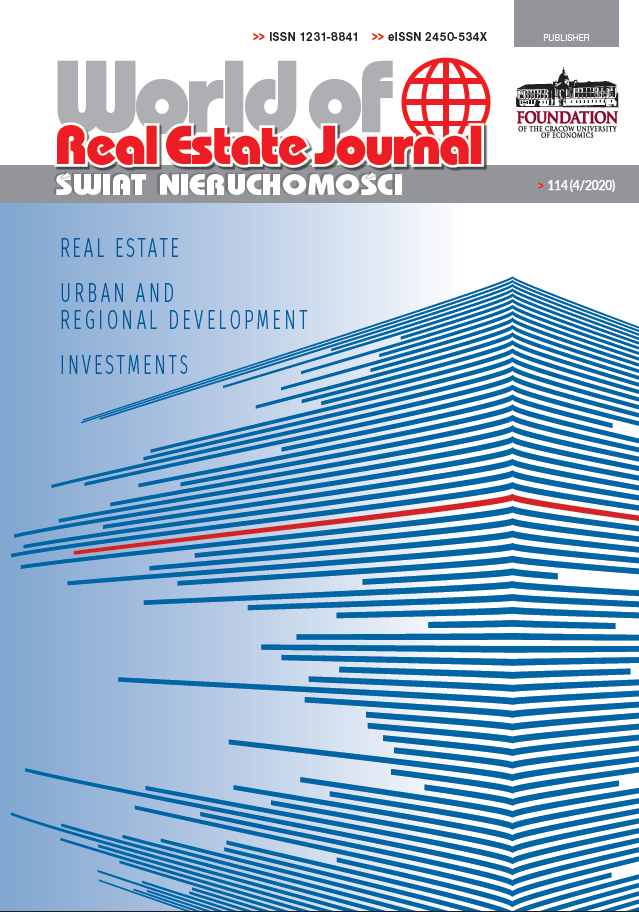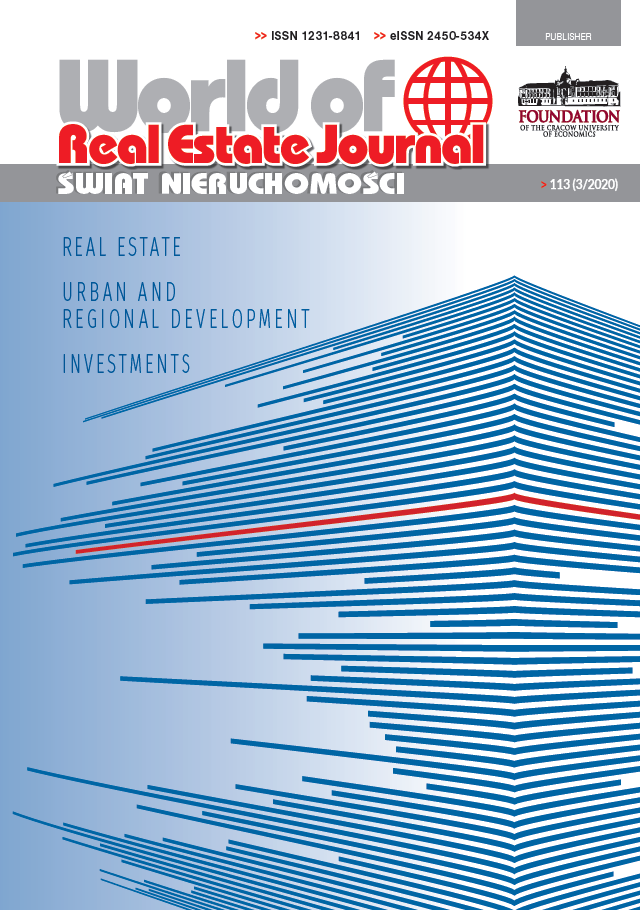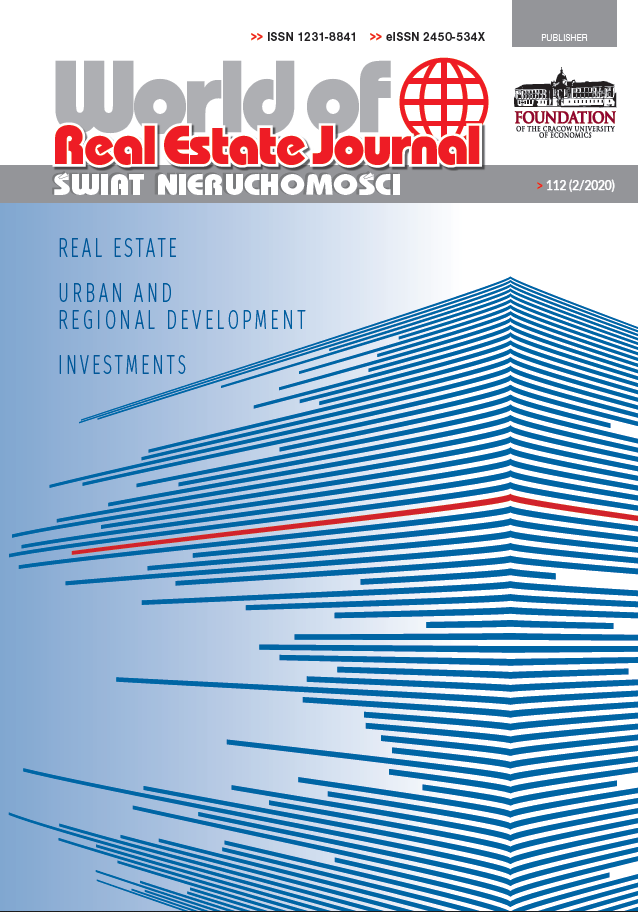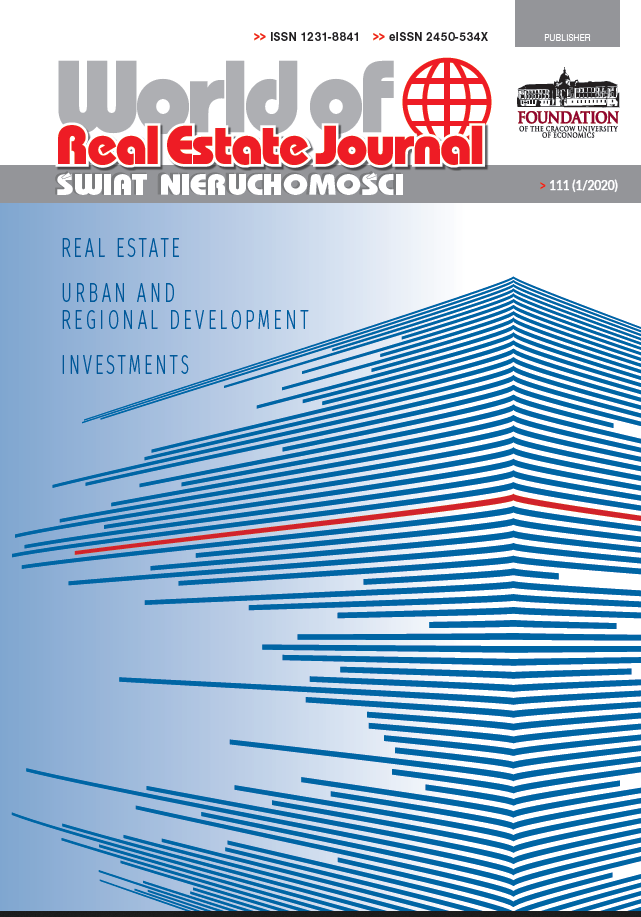INVESTMENTS
1) Maciej J. Nowak, Paweł Kreja - Decisions on building conditions and land development as a spatial policy instrument in “Polish metropolises”
2) Krzysztof Zima, Edyta Plebankiewicz - The influence of the building shape on the costs of its construction
3) Cezary Tomasz Szyjko -Energy Efficient Stadiums for Euro 2012
4) Dariusz Trojanowski, Paweł Kisiel - Price calculation of water supply and sewage networks to be purchased by supply companies - rent capitalization method
MARKET
5) Aleksandra Łużna - Branding in the real estate market
6) Bartłomiej Marona - Office and retail real estate market in Kraków – short term forecast
7) Janusz Nesterak, Mariusz Stepaniuk - The role of bank controlling in property development investments
HOUSING
8) Gabriel Główka - Prospects for housing finance system in Poland
9) Elżbieta Twardowska - Social housing – meeting housing needs of the poor
REAL ESTATE MANAGMENT
10) Agnieszka Bieda, Piotr Parzych - Designation of cadastral boundaries position in the neighborhood of rivers for tax purposes
CHANGES IN LAW
11) Maciej J. Nowak - the developer act and the rules for the limitation of excersising rights on real estate DOWNLAND
CONFERENCES
12) Monika Glądys - International scientific symposium "Real Estate Market ; poland vs. Slovakia" (Bratislava, 16th - 18th March 2012) DOWNLAND
SUMMARIES
Maciej J. Nowak, Paweł Kreja - Decisions on building conditions and land development as a spatial policy instrument in “Polish metropolises”
The aim of this article is to identify the role played by the decision on building conditions and land use in the development of a group of cities, the so called “Polish metropolises”, that is Gdańsk, Poznań, Kraków, Łódź and Wrocław. These are the cities classified in a hierarchy decidedly lower than Warsaw, but regardless of this fact they are consistently named the most developed cities in Poland. The article also analyzes the role played by the decisions in local and regional development along with their practical dimensions, manifesting itself in the number of issued decisions and the number of denials concerning building conditions.
Krzysztof Zima, Edyta Plebankiewicz - The influence of the building shape on the costs of its construction
The choice of a particular architectural solution when designing a building considerably influences the costs of its construction. Generally speaking, the more complex the form of the horizontal projection is, the greater expenditures for the construction must be paid. The article presents the indexes which may relate to the complexity of the building shape and which were then specified and compared on a specific example. For the selected elements of the exemplary building the change in expenditures were analyzed in relation to the degree of shape complexity. Examples of the influence of the building shape on the size of the usable floor area and costs of formwork of the premises were also discussed.
Cezary Tomasz Szyjko - Energy Efficient Stadiums, Euro 2012
Current environmental and climate change concerns clearly illustrate the need to strive towards more resource efficient and eco-innovative production processes. As part of the EU Action Plan on Sustainable Consumption and Production and Sustainable Industrial Policy the European Commission initiated the latest revision of EMAS in order to fully exploit the scheme’s potential for improving the resource efficiency of production processes. Sustainable growth based on a more resource-efficient, greener and more competitive economy is also part of in the EURO 2012 CHAMPIONSHIP. Stadiums resource efficiency, achieved by economic factors from energy use, is one of the Poland-Ukraine “flagship” initiatives.
Dariusz Trojanowski Paweł Kisiel - Price calculation of water supply and sewage networks to be purchased by supply companies - rent capitalization method
Under the conditions of the Polish economic life municipalities tend to, more and more often, transfer the operational management of water supply and sewage networks to companies specially created with that goal in mind. A company performing tasks which have a public utility character has, on the one hand, a typical owner, i.e. the municipality (territorial self-government units such as municipalities should naturally operate as non-profit entities), but, on the other hand, it is a business entity which should operate in a market environment and its management team should make profit-oriented rational and economically justified decisions. The paper is an attempt to indicate the ways of calculating the price which may be applied by utility supplying companies to appropriately set the sales value of water supply and sewage networks built by a “private” investor. Two methods are considered based on the method of discounting cash flows. In the first paper of the series, the authors describe the specific character of the goods offered for sale – that is the water supply and sewage network - and focus their attention on the use of the Net Present Value method for the calculation of the sales price of the network.
Aleksandra Łużna - Branding in the real estate market
The aim of the article is to substantiate the relevance of branding concepts to the real estate, considering the current real estate market conditions, social trends as well as the modern marketing theory. The paper proposes how to define a real estate brand and offers preliminary systematics. An attempt is made to indicate the substance of the real estate brand management as well as to identify the key stakeholders’ advantages of employing brand concept to real estate.
Bartłomiej Marona - Office and retail real estate market in Kraków – short term forecast
The paper presents an excerpt of the analysis results made for Małopolska Regional Development Agency. The complete results of the research will be published in the report “Real Estate in Małopolska, Business in Małopolska 2012”. The main objective of this paper is to demonstrate current performance of retail and office real estate market in Krakow and present a short term forecast for the years 2012 – 2013.
Janusz Nesterak Mariusz Stepaniuk - The role of bank controlling in property development investments
Economic downturn has led to the need of carrying out a more thorough analysis of developers and banks performance. The results of this analysis have dramatically changed the way they operate in the market. During the recent crisis, the application of an internal management tool, i.e. bank controlling, has gained both in intensity and importance. This internal management tool guidelines have prevented the developer market from collapsing and saved many investors from bankruptcy.
Gabriel Główka - Prospects for housing finance system in Poland
Due to its strong link with the financial sector, the development of housing market is greatly impacted by the financial system. Even though the mechanisms and methods of financing this market evolve constantly, the basic instruments still remain bank products, especially mortgage loans. For this reason, alongside several macroeconomic conditions, such as housing needs of the society, the level of investment and savings as well as the labour market and economic conditions, an adequate supply of and access to mortgage loans, is prerequisite for the development of the housing market. The purpose of this article is therefore to assess the financial system linked to the residential real estate market in Poland as well as identify the trends and determine where changes ought to be made.
Elżbieta Twardowska - Public housing – meeting housing needs of the poor
Due to the growth in dwelling maintenance costs, the rising rent rates and population impoverishment, the households’ demand for public flats is increasing. Unfortunately, the municipal housing assets do not increase at the same pace. The aim of the paper is to assess the current economic and social situation of communal resources in relation to the public housing in Poland and the potential directions of their development. It is intended to discuss, to what extent the current resources of public flats meet the housing needs of the Polish low-income population.
Agnieszka Bieda Piotr Parzych - Designation of cadastral boundaries position in the vicinity of rivers for tax purposes
In the recent years issues relating to the property borders have become increasingly topical. This is related to the growing public awareness of property whereby boundaries-determined range of property rights becomes an essential issue. This is important also because of the variety of charges related to property resulting from plots. Indication of borders position usually causes no trouble for surveying contractors. If, however, when the parcel is located in the vicinity of flowing water demarcation becomes difficult and requires the use of algorithms proceeding arising out of the water rights. During their implementation these are important: the correct interpretation of geodetic and legal documentation and the ability to combine knowledge bordering geodesy and hydrology.





















































